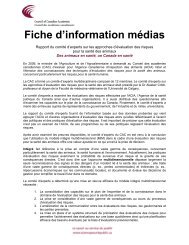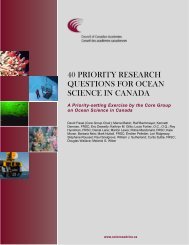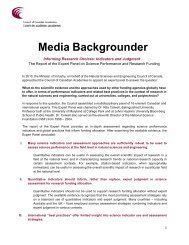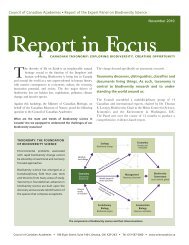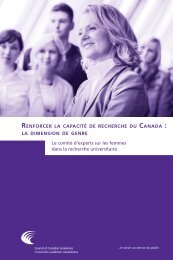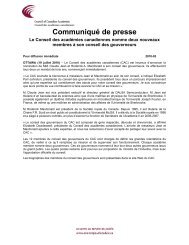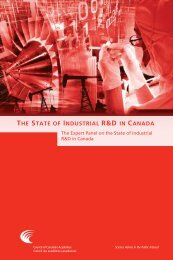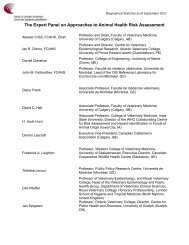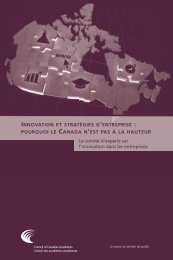an assessment of the evidence - Council of Canadian Academies
an assessment of the evidence - Council of Canadian Academies
an assessment of the evidence - Council of Canadian Academies
- No tags were found...
You also want an ePaper? Increase the reach of your titles
YUMPU automatically turns print PDFs into web optimized ePapers that Google loves.
28 Influenza Tr<strong>an</strong>smission <strong>an</strong>d <strong>the</strong> Role <strong>of</strong> PPRE: An Assessment <strong>of</strong> <strong>the</strong> Evidencedo not provide information about which viral illnesses were prevented or <strong>an</strong>yinformation specific to influenza.Given <strong>the</strong> large amount <strong>of</strong> virus contained in ballistic particles that would survivefor prolonged periods <strong>of</strong> time in <strong>the</strong> environment (that could cause infection onlyby direct deposition onto mucous membr<strong>an</strong>es or by surface contact followed byself-inoculation), it is reasonable to postulate that contact tr<strong>an</strong>smission might occur.In fact, preliminary data from a guinea pig model <strong>of</strong> influenza demonstrates thatcontact tr<strong>an</strong>smission <strong>of</strong> influenza occurs, but is less efficient th<strong>an</strong> tr<strong>an</strong>smission viainhalation (Palese, 2007; Mubareka, 2007). However, no <strong>evidence</strong> has been foundthat h<strong>an</strong>d hygiene or o<strong>the</strong>r interventions that might prevent contact tr<strong>an</strong>smission(e.g., glove use in healthcare facilities) prevent <strong>the</strong> tr<strong>an</strong>smission <strong>of</strong> influenza.The p<strong>an</strong>el concludes that although <strong>the</strong> occurrence <strong>an</strong>d relative import<strong>an</strong>ce <strong>of</strong> <strong>the</strong>contact route for influenza tr<strong>an</strong>smission have not been demonstrated, or indeedstudied in hum<strong>an</strong>s, contact tr<strong>an</strong>smission likely occurs.THE ROLE OF SETTING IN TRANSMISSIONEvidence on <strong>the</strong> effect <strong>of</strong> setting on influenza tr<strong>an</strong>smission is sparse. One setting inwhich tr<strong>an</strong>smission <strong>of</strong> influenza is <strong>of</strong> particular interest is healthcare institutions.Because healthcare workers take care <strong>of</strong> patients with influenza, it may seem logicalthat <strong>the</strong>y would be at higher risk th<strong>an</strong> o<strong>the</strong>rs <strong>of</strong> being infected. However, becausemost illness due to seasonal influenza is not severe, <strong>the</strong> majority <strong>of</strong> contact with, <strong>an</strong>dcare for, people with influenza occurs in <strong>the</strong> community. In addition, influenza isshed in highest qu<strong>an</strong>tities in <strong>the</strong> first days <strong>of</strong> illness – i.e., generally before hospitalization(Hayden, 1999). Thus exposure to influenza is widespread in <strong>the</strong> community.A very limited number <strong>of</strong> studies provide <strong>evidence</strong> about whe<strong>the</strong>r healthcare workersare at higher risk <strong>of</strong> exposure to influenza th<strong>an</strong> o<strong>the</strong>r adults. All studies have been<strong>of</strong> workers in acute care hospitals. The most frequently cited is that <strong>of</strong> Elder et al.(1996), in which 120 <strong>of</strong> 518 (23 per cent) unvaccinated British hospital workers hadserologically confirmed influenza during <strong>the</strong> 1993-1994 influenza season. This<strong>an</strong>nual rate <strong>of</strong> influenza infection (symptomatic <strong>an</strong>d asymptomatic) is relativelyhigh but not beyond <strong>the</strong> usual r<strong>an</strong>ge (Fox, 1982; Monto, 1985). However <strong>the</strong>sestudies did not measure <strong>the</strong> rate <strong>of</strong> infection in o<strong>the</strong>r adults. 14 In <strong>an</strong>o<strong>the</strong>r study,Wilde et al. (1999) reported overall rates <strong>of</strong> infection in unvaccinated healthcareworkers r<strong>an</strong>ging from 7 to 28 per cent (medi<strong>an</strong> 14 per cent) in influenza seasons





